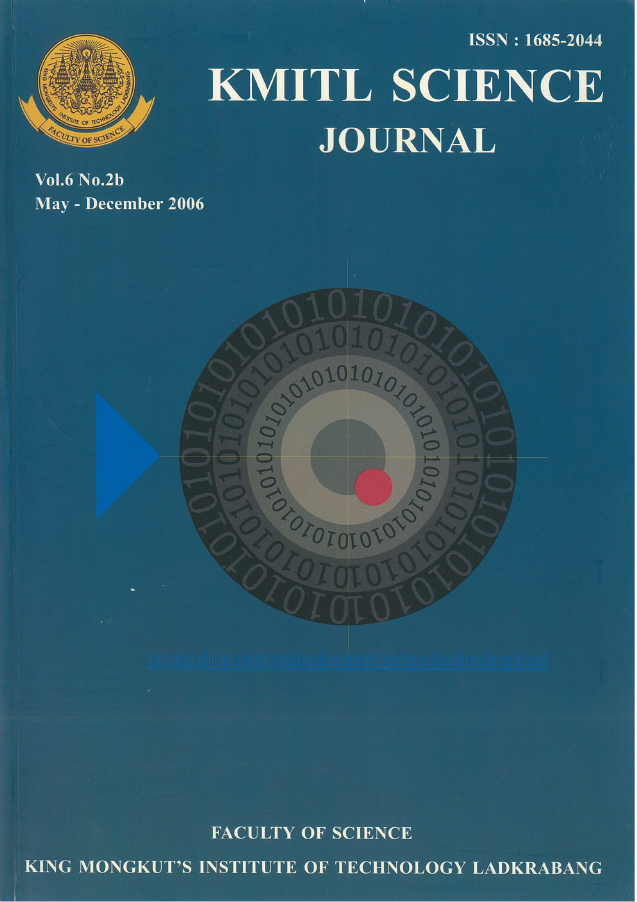The Effect of Molasses for Lysine Production by Arthrobacterium citreus NRRL 1258 and Corynebacterium glutamicum ATCC 21475
Main Article Content
Abstract
The essential amino acid L-lysine was produced in a batch fermentation by Arthrobacterium citreus NRRL 1258 and Corynebacterium glutamicum ATCC 21475. Molass, a food by-product from a sugar mill, was chosen for this study. The main objective was to replace glucose with molasses in order to make use of this by-product and also to reduce total production costs of L-lysine. The results revealed that the growth of Arthrobacterium citreus NRRL 1258 and Corynebacterium glutamicum ATCC 21475 did not follow the simple Monod’s kinetics. Growth inhibition by the product (L-lysine) occurred during fermentation. Substrate (molasses) inhibition at higher concentrations (100, 120 g/l) were exhibited against growth. The concentration of 40 g equivalent sugar/l molasses gave the highest lysine yield of 25.14 g/l for Arthrobacterium citreus NRRL 1258 and of 24.95 g/l for Corynebacterium glutamicum ATCC 21475. In addition, the statistical analysis showed that there was no significant difference of P>0.05 between molasses (40 g/l) and the synthetic glucose (80 g/l). This study clearly indicate that molasses (40 g/l) was a carbon suitable source in the lysine production process.
Keywords: Molasses, Arthrobacterium citreus, Corynebacterium glutamicum, Lysine Production
Corresponding author: E-mail: kjmasrisa@kmitl.ac.th
Article Details
Copyright Transfer Statement
The copyright of this article is transferred to Current Applied Science and Technology journal with effect if and when the article is accepted for publication. The copyright transfer covers the exclusive right to reproduce and distribute the article, including reprints, translations, photographic reproductions, electronic form (offline, online) or any other reproductions of similar nature.
The author warrants that this contribution is original and that he/she has full power to make this grant. The author signs for and accepts responsibility for releasing this material on behalf of any and all co-authors.
Here is the link for download: Copyright transfer form.pdf
References
[2] Collo, N., L. Brito and Nonus, M. 2000. Biosynthesis of L-lysine by Corynebacterium glutamicum Grown on Fish Silage. Bioresource Boitechnology. 73, 2000, 221-225.
[3] Kiefer, E.H. and Wittmann, C. 2002. Influence of glucose, fructose and sucrose as carbon sources on kinetics and stoichinometry of lysine production by Corynebacterium glutamicum, J. Ind. Microbiol. Biotechnol. 28, 338-343.
[4] Umerie, S.C., Ekwealor, I.A. and Nwagbo, I.O. 2003. Lysine production by Bacillus laterosporus from various carbohydrate and seed meals. Bioresource Biotechnology. 75, 249-252.
[5] Gessesse, A.1997. The use of nugmeal as a low-cost substrate for the production of alkaline protease by alkaliphilic Bacillus sp.AR-009 and some properties of the enzyme. Bioresource Technology. 62, 59-61.
[6] Ruklisha. M., Ruklisha, R., Ionina, Paegle, L. and Petrovica, G. 2001. Metabolism and lysine biosynthesis control in Brevibacterium flavum: impact of stringent response. In: Simon J.-P. and Durieux, A., Ed. Applied Microbiology. Kluwer Academic Publishers, Dordrecht, Boston, London, pp. 51-57.
[7] Kimura, K. 2003. Metabolic engineering of glutamate production. In: Thommel, J. and Faurie, R. Ed. Advances in Biochemical Engineering/Biotechtechnology vol. 79, Springer-Verlag, Berlin Heidelberg, pp. 37-57.
[8] Pham, C.B., Galvez, C.F. and Padolina, W.G., 1992. Methionine production by batch fermentation from various carbohydrates. ASEAN Food Journal 7, pp. 34-37.
[9] Kazushige, O. and Charles E. G. 2000. Effect of carbon source on microfiltration of Corynebacterium glutamicum. J. of Membrane Science. 171, 263-271.


